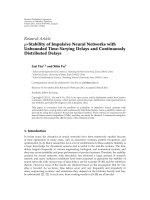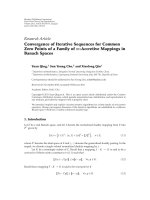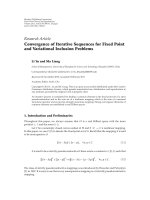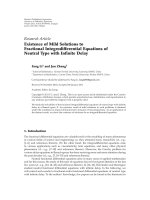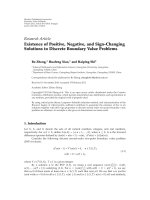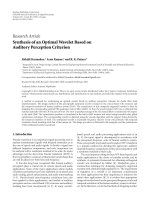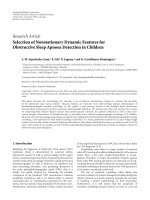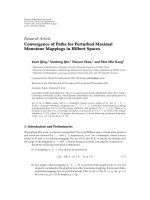Báo cáo hóa học: " Research Article Estimation of Radar Cross Section of a Target under Track" potx
Bạn đang xem bản rút gọn của tài liệu. Xem và tải ngay bản đầy đủ của tài liệu tại đây (673.07 KB, 6 trang )
Hindawi Publishing Corporation
EURASIP Journal on Advances in Signal Processing
Volume 2010, Article ID 610920, 6 pages
doi:10.1155/2010/610920
Research Article
Estimation of Radar Cross Section of a Target under Track
Young-Hun Jung,
1
Sun-Mog H ong,
2
and Seung Ho Choi
3
1
Agency for Defense Development, Yuseong P.O. Box 35-1, Daejeon 305-600, Republic of Korea
2
School of EE, Kyungpook National University, Daegu 702-701, Republic of Korea
3
Department of EIE, Seoul National University of Technology, Seoul 139-743, Republic of Korea
Correspondence should be addressed to Sun-Mog Hong,
Received 19 April 2010; Accepted 6 October 2010
Academic Editor: Frank Ehlers
Copyright © 2010 Young-Hun Jung et al. This is an open access article distributed under the Creative Commons Attribution
License, which permits unrestricted use, distribution, and reproduction in any medium, provided the original work is properly
cited.
In allocating radar beam for tra cking a target, it is attempted to maintain the signal-to-noise ratio (SNR) of signal returning from
the illuminated target close to an optimum value for efficient track updates. An estimate of the average radar cross section (RCS)
of the target is required in order to adjust transmitted power based on the estimate such that a desired SNR can be realized. In
this paper, a maximum-likelihood (ML) approach is presented for estimating the average RCS, and a numerical solution to the
approach is proposed based on a generalized expectation maximization (GEM) algorithm. Estimation accuracy of the approach is
compared to that of a previously repor ted procedure.
1. Introduction
Beam al location in phased array radar tr acking is a well-
known problem, and it has been addressed in a large body
of literature [1–6] and the references therein. A goal of the
allocation is to minimize the use of radar resources while
maintaining a target under track. In the allocation for a track
update, one of the principal parameters to be adjusted is
transmitted power. The transmitted power has an impact
on the signal-to-noise ratio (SNR) of return signal from an
illuminated target. The SNR is directly proportional to the
transmitted power and the radar cross section (RCS) of the
target [7, 8].
It is often attempted to maintain SNR close to an
optimum value for efficient track updates. The tra nsmitted
power is adjusted in the attempt such that a desired SNR can
be realized. Since the target RCS is unknown, it is required to
adjust the power based on an estimate of the average RCS [7].
An algorithmic procedure for estimating the average RCS was
proposed in [1, 2]. The procedure, denoted by MED, adjusts
the RCS estimate, depending on the median difference
between the SNR measurements of return signals in a sliding
window and their corresponding expected values. In this
paper, a maximum-likelihood (ML) approach is presented
for estimating the average RCS, and a numerical solution to
the approach is proposed based on a generalized expectation
maximization (GEM) algorithm. Numerical experiments
were performed to compare estimation performance of the
ML approach with that of MED. The experimental results
show that ML estimation can perform successfully even for
a low SNR target that MED fails to estimate.
2. RCS Model
The radar cross section depends on many factors, including
electromagnetic scattering properties of a target and aspect
angles, and it is often statistically char acterized by a Swerling
model [7]. We assume that the fluctuation model of target
RCS under consideration is Swerling I. The received signal
strength of a target with the fluctuation varies independently
from scan to scan, and it is characterized as an exponential
random variable. The signal strength at scan k normalized
with respect to the noise spect ral density, denoted by z
k
,has
a probability density function (pdf)
f
(
z
k
)
=
1
1+SNR
k
· exp
−
z
k
1+SNR
k
,(1)
where
SNR
k
denotes the average S NR at scan k. Note that
SNR
k
is proportional to the average RCS, denoted by σ. That
2 EURASIP Journal on Advances in Signal Processing
is,
SNR
k
= α
k
σ,whereα
k
is a known constant that depends
on target range and transmitted power at k [7].
The detection of a target takes place when the received
signal strength is higher than a specified threshold that can
be represented in terms of the false alarm probability P
F
.To
be specific, the detection occurs if
z
k
≥− ln P
F
. (2)
The target detection of (2) defines the relationship between
the probability of detection at k (P
Dk
), the false alarm
probability P
F
,andSNR
k
such that
P
Dk
= P
1/(1+SNR
k
)
F
. (3)
The false alarm probability P
F
represents the probability of
detecting a false measurement due to noise interference. Note
that P
F
is a predetermined constant.
3. ML Estimation of RCS
An algorithmic procedure for estimating the average RCS was
proposed in [1, 2]. The procedure (denoted by MED) adjusts
the average RCS estimate by 0.5 dB whenever the median
difference between SNR measurements of return signals in
a sliding window and their corresponding expected values
is 1 dB or greater. In the case of a missed detection, the
estimate is decreased by 0.5 dB. We adopt the acronym MED
to represent the procedure, since it uses the median as its
statistic. In this sec tion, a maximum-likelihood approach for
estimating the average RCS
σ and its numerical solution is
presented. Along the context of the problem posed in [1, 2],
we assume that the false alarm probability P
F
is small enough
so that, if a detection occurs, it is from the target under track.
Under this assumption, we obtain an estimate of
σ from a
sequence of detections and misses over a sliding window.
Suppose that
σ is constant over a sliding window, and
suppose that we have a sequence of N detections and M
missed detections in the window. Denote by D the index
set of scans with detection and by
D the index set of scans
with no detection. Also, let us denote by D
k
the event
that detection occurs at scan k. Since the received signal
strength is independent from scan to scan, the misses and
detections form an independent sequence. Specifically, the
probability-pdf of the observations is given by c
·(
i∈D
f (z
i
|
D
i
)) · (
i∈D
P[D
i
]) · (
j∈D
(1 − P[D
j
])), where c is the
normalizing constant and f (z
i
| D
i
) is the conditional pdf
of signal strength g iven the event D
i
. Substituting (1)and
(3)with
SNR
k
= α
k
σ into the probability-pdf, we obtain the
incomplete-data log-likelihood function for the parameter
σ,
which is g iven by
ln L
(
σ
)
=−
i∈D
ln
(
1+α
i
σ
)
+
z
i
1+α
i
σ
+
j∈D
ln
1 − P
1/(1+α
j
σ)
F
.
(4)
The maximum-likelihood estimate of the average RCS is
represented by
σ
ML
= arg max
σ
ln L
(
σ
)
. (5)
The ML solution to (5) appears to be analytically
intractable, and we apply the expectation maximization
(EM) algorithm to obtain the solution. The EM algorithm
is an efficient iterative procedure for finding the ML estimate
of model parameters from a given data set in the presence
of incomplete or missing data [9]. Note that various target-
tracking problems have been formulated and solved in the
framework of the EM algorithm [10–15]. Let us denote
by
D
j
the event that a miss occurs at scan j,andbyy
j
the unknown (or missing) signal strength of the miss. The
complete-data likelihood function L
c
(σ) for the parameter σ
is defined by
L
c
(
σ
)
=
⎛
⎝
i∈D
f
(
z
i
| D
i
)
⎞
⎠
·
⎛
⎝
i∈D
P
[
D
i
]
⎞
⎠
·
⎛
⎜
⎝
j∈D
P
D
j
⎞
⎟
⎠
·
⎛
⎜
⎝
j∈D
f
y
j
| D
j
⎞
⎟
⎠
,
(6)
where f (y
j
| D
j
) is the conditional pdf of the missing signal
strength given the event
D
j
, that is,
f
y
j
| D
j
=
1 − P
1/(1+α
j
σ)
F
−1
1
1+α
j
σ
exp
−
y
j
1+α
j
σ
,
0 <y
j
< − ln P
F
,
(7)
and zero, otherwise. The complete-data likelihood function
can be written as
L
c
(
σ
)
=
i∈D
1
1+α
i
σ
exp
−
z
i
1+α
i
σ
·
j∈D
1
1+α
j
σ
exp
−
y
j
1+α
j
σ
,
(8)
and the complete-data log-likelihood function is given by
ln L
c
(
σ
)
=−
i∈D
ln
(
1+α
i
σ
)
+
z
i
1+α
i
σ
−
j∈D
ln
1+α
j
σ
+
y
j
1+α
j
σ
.
(9)
Define by Q(
σ, σ
(l−1)
) the expectation of the complete-data
log-likelihood function with respect to the unknown signal
strength, given the observations
{z
i
: i ∈ D} and the current
parameter estimate
σ
(l−1)
. That is,
Q
σ, σ
(l−1)
=
E
ln L
c
(
σ
)
|{z
i
: i ∈ D}, σ
(l−1)
. (10)
EURASIP Journal on Advances in Signal Processing 3
In the lth iteration of the EM algorithm, the expectation
Q(
σ, σ
(l−1)
) is maximized with respect to σ,andσ
(l)
is
updated with the maximizer as
σ
(l)
= arg max
σ
Q
σ, σ
(l−1)
. (11)
Note that each iteration is guaranteed to increase the
log-likelihood function (4) and the EM algorithm leads
σ
(l)
ultimately to the value that maximizes the likelihood
function [9].
The conditional expectation Q(
σ, σ
(l−1)
) of the complete-
data log-likelihood function (9)canberewrittenas
Q
σ, σ
(l−1)
=−
i∈D
ln
(
1+α
i
σ
)
+
z
i
1+α
i
σ
−
j∈D
⎛
⎝
ln
1+α
j
σ
+
g
α
j
σ
(l−1)
1+α
j
σ
⎞
⎠
,
(12)
where g(α
j
σ
(l−1)
) = E[y
j
| σ
(l−1)
] that is given by
g
α
j
σ
(l−1)
=
1+α
j
σ
(l−1)
+
1 − P
1/(1+α
j
σ
(l−1)
)
F
−1
P
1/(1+α
j
σ
(l−1)
)
F
ln P
F
.
(13)
Unfortunately, it appears infeasible to obtain the maximizer
of (12) in an analytic form. Instead, we evaluate
σ
(l)
in each
iteration by
σ
(l)
=
1
W
⎛
⎜
⎝
i∈D
z
i
− 1
α
i
+
j∈D
g
α
j
σ
(l−1)
−
1
α
j
⎞
⎟
⎠
, (14)
where W denotes the length of the sliding window and it is
the sum of the number of detections (N), and the number
of misses (M) in the window. Note that the function (14)
corresponds to an average of the estimates of
σ that are
obtained based on the observations of the detections and
misses in the window. To be more specific, (z
i
− 1)/α
i
in
the first term of (14) is an (one-sample) unbiased estimate
of
σ with the observed signal strength z
i
of the detection at
scan i,and(g(α
j
σ
(l−1)
) − 1)/α
j
in the second term is also an
one-sample estimate of
σ with the unobserved but estimated
signal strength g(α
j
σ
(l−1)
) of the missed detection at scan j.
Recall that the unobserved signal strength is estimated by
(13) which evaluates the expected value of the undetected
signal strength distributed with the pdf of (7)with
σ = σ
(l−1)
.
It can be shown that the iteration with the mapping
(14) forms an instance of a GEM algorithm [9] in the
following cases: where α
k
’s are a constant over a sliding
window with scans appearing in (14), and where α
k
σ
(l)
’s
and α
k
σ
(l−1)
’s are sufficiently large. In these cases, the
sequence
{σ
(l)
} of (14) satisfies the sufficient conditions (in
Theorem 2 of [9]) for convergence to a ML estimate. In the
event that the mapping (14) fails to satisfy the inequality
Q(
σ
(l)
, σ
(l−1)
) ≥ Q(σ
(l−1)
, σ
(l−1)
), a possible simplest step is
Table 1: RMS estimation errors for σ = 1.
SNR (P
D
)
8 (0.46) 16 (0.67) 32 (0.81) 64 (0.90)
ML(N = 5) 0.362 0.392 0.417 0.426
ML(N
= 10) 0.252 0.278 0.290 0.307
ML(W
= 7) 0.439 0.405 0.384 0.387
ML(W
= 10) 0.360 0.337 0.326 0.317
ML(W
= 12) 0.332 0.311 0.297 0.295
ML(W
= 15) 0.298 0.273 0.266 0.263
MED — 0.331 0.340 0.364
1 5 10 15 20 25
10
−1
10
0
Scan k
RCS estimation error (RMS)
ML(N = 10), SNR
=
16
MED,
SNR = 16
ML(N
= 10), SNR = 32
MED,
SNR = 32
Figure 1: RMS estimation errors for σ = 0.375.
to stop the iteration and return σ
(l−1)
as an estimate. The
GEM algorithm was implemented to compute a ML estimate,
and its estimation performance is discussed in the following
section.
4. Numerical Experiments
We performed numerical experiments to investigate RCS
estimation performance of the ML approach. The ML
estimates were evaluated with iterations of (14) that form
an implementation of the GEM algorithm. The algorithmic
procedure MED was also implemented and its performance
was compared with that of the ML estimation. The procedure
estimates the average RCS using the median difference
between SNR measurements of return signals in a sliding
window and their corresponding expected values. The
procedure uses z
k
− 1 as the measurement of SNR at scan k
[3] and a sliding window with 5 detections. The experiments
were performed for P
F
= 10
−3
.
Firstly, we obtained the root-mean-squared (RMS) esti-
mation errors of the average RCS (
σ), when the true value
4 EURASIP Journal on Advances in Signal Processing
1 5 10 15 20 25
Scan k
RCS estimation error (RMS)
ML(N = 10), SNR
=
16
MED,
SNR = 16
ML(N
= 10), SNR = 32
MED,
SNR = 32
0
0.1
0.2
0.3
0.4
0.5
0.6
0.7
0.8
Figure 2: RMS estimation errors for σ = 1.5.
1 5 10 15 20 25
Scan k
RCS estimation error (RMS)
ML(N = 10), SNR
=
16
MED,
SNR = 16
ML(N
= 10), SNR = 32
MED,
SNR = 32
1.5
2
2.5
3
3.5
4
4.5
5
Figure 3: RMS estimation errors for σ = 6.
is unity. The results are presented in Table 1.Theerrorsof
ML estimation were evaluated for a sliding window with a
fixed size and for a sliding window with a fixed number
of detections in it. In the table, ML(N
= n)denotesML
estimation using a sliding window with n detections, and
ML(W
= w) denotes ML estimation using a sliding window
with a fixed length w. Note that the window size of ML(W
=
w)isfixedtow regardless of the number of detections in the
window. On the contrary, the window size of ML(N
= n)
can change to retain n detections in the window. The average
SNR,
SNR, was set to a constant having a value of 8, 16, 32,
and 64. Note that each of the RMS errors in the table was
obtained based on 10
5
estimates evaluated along a random
sequence of detect ions and misses. The random sequence
was generated according to the signal and detection model
described in Section 2. The iteration of (14) stops when the
step size becomes less than 10
−3
.
The table shows that the RMS errors of ML(N
= 5) and
ML(N
= 10) decrease with SNR. It appears counterintuitive,
but the decrease is due to more information on
σ gathered
over a sliding window whose length increases in average as
SNR decreases. Note that as SNR decreases, the probability of
detection decreases, and more scans are required in average
to retain a specified number of detections. In contrast, the
RMS error of ML(W
= w) decreases as SNR increases. This
implies that detections are more informative than misses
in estimating
σ, since they provide additional information
on
σ via signal strength observations. In all cases, the error
decreases as the window size increases through W or N.
The window size of ML(N
= n) corresponds to the size of
ML(W
= w)ineffect with w = n/P
D
. For instance, N = 10
corresponds approximately to W
= 15 for SNR = 16 (P
D
=
0.67) and W = 12 for SNR = 32 (P
D
= 0.81). Table 1
shows that the errors of ML(N
= 10) and ML(W = 15)
are 0.278 and 0.273 for
SNR = 16, respectively, and those
of ML(N
= 10) and ML(W = 12) are 0.290 and 0.297 for
SNR = 32, respectively. The numbers are comparable to each
other, and it implies that ML(N) does not have any particular
advantages over ML(W)inpractice.
The table also shows that MED outperforms ML(N
= 5)
and ML(W
= 7) for higher signal strength, but it is less
effective than ML(N
= 10) and ML(W = 10). It should
be remarked that MED failed to estimate
σ for SNR = 8
(the estimates of MED were close to zero). Note that MED
uses a sliding window with 5 detections. We also p erformed
numerical experiments to obtain the RMS errors of MED
for a sliding window with 10 detections. It failed again to
estimate
σ for SNR = 8, and all the errors for higher SNR’s
were larger than those of MED with 5 detections. It appears
that MED was designed based on 5 detections and it needs
a modification for a different number of de tections to assure
its best performance. The experimental results indicate that
ML estimation can perform successfully for a low SNR target
that MED fails to estimate. The computational cost of ML
estimation was not significant. The GEM terminated in 3.59
iterations of (14)inaverageandinmaximum5iterationsto
yield a ML estimate.
Additional experiments were performed to investigate
estimation accuracy at the early stage of tracking. The
ensemble averaged RMS errors are presented in Figures 1
to 4 for the true value of
σ with 0.375, 1.5, and 6. The
average was evaluated over 10
5
time sequences of estimates.
The track was initiated according to the “3 out of 5” logic
[16], and the estimation is activated at the third detection
of the initiation logic. The scan index k was set to one at
the start, and the initial value of the RCS estimate was set
to 1.5. The window size of ML(N
= 10) was adjusted to
continue to increase until the window holds 10 detections
and to maintain 10 detections at subsequent scans. Figures 1
EURASIP Journal on Advances in Signal Processing 5
1 5 10 15 20 25
Scan k
RCS estimation error (RMS)
0.3
0.35
0.4
0.45
0.5
0.55
0.6
(a) SNR = 16
1 5 10 15 20 25
Scan k
RCS estimation error (RMS)
0.35
0.4
0.45
0.5
0.55
0.6
0.65
0.7
ML(N
= 10)
ML(W
= 10)
ML(W = 12)
ML(W
= 15)
(b) SNR = 32
Figure 4: RMS estimation errors for σ = 1.5.
and 3 show that the ML estimation is much more accurate
than MED at the first 10 scans. Figure 2 presents the RMS
errors for the case that the initial estimate of MED is perfect.
In this case, the error of MED is zero at the first and
second scans. Note that the ML estimation, however, is not
susceptible to the accuracy of a preset initial value of the RCS
estimate.
Figures 1 to 3 show that the errors for
SNR = 16 each
decrease eventually to the values slightly lower than those for
SNR = 32. This observation is consistent with the results
presented in Table 1. Note, furthermore, that ML (N
= 10)
maintains the error for
SNR = 16 to be smaller than that
for
SNR = 32 at all scans. This confirms that the argument
on the results of the table holds for ML (N
= 10) over all
scans, including the early stage of tracking. In contrast, MED
decreases its error faster at the early stage for
SNR = 32
than for
SNR = 16; see Figures 1 and 3. This is the case
where the initial estimate error is larger than the “steady-
state” error. In this case, MED is activated and starts to
correct the estimation error at an earlier scan for
SNR = 32
since the window can retain 5 detections faster when the
probability of detection is hig her. This correction allows to
pass a more accurate initial estimate to the MED estimation
of the following scan and causes the estimation error to
decrease faster. Conversely, MED starts to miscorrect the
error at an earlier scan for
SNR = 32 in Figure 2,where
the initial estimate error is smaller than the “steady-state”
error. This miscorrection passes a worse initial estimate to
the MED estimation of the next scan. This affects adversely
the estimation and causes the error to increase faster.
Figure 4 presents the RMS errors of ML(N
= 10) and
ML(W
= w), w = 10, 12, and 15, for σ = 1.5. At the
early scans, ML(N
= 10) and ML(W = w) use the same
windows and the RMS errors coincide as a consequence.
The “steady-state” errors are also consistent with the results
presented in Table 1. The transient “dynamics” of ML(W)
can be described as follows. ML(W) starts at scan 1 with
three detections as it is activated according to the “3 out of
5” track initiation logic. The three detections according to
the logic requires 3.9 and 3.6 scans in average for
SNR = 16
and 32, respectively. This implies that ML(W
= w)requires
w
− 3.9andw − 3.6 more scans in average for SNR = 16 and
32, respectively, to stop expanding its window. Suppose that,
for instance, w
= 12. In this case, the stopping starts to occur
at scan 8 and occurs in average between scans 9 and 10. Note
that the statistical characteristics of the observations before
and after k
= 1aredifferent due to the track initiation logic,
since the logic intervenes in effect to select observations with
a higher probability to retain more detections in the window
at scans earlier than and at scan 1. The detections are more
informative than misses in the RCS estimation. It is shown
in Figures 4(a) and 4(b), respectively, that ML(W
= 12)
begins to lose the better quality information by releasing the
detections from the window and its errors start to increase
at scan 8 and at scan 9. This explains the reason that the
“undershoot” occurs at scan 8 and scan 9, respectively, for
SNR = 16 and 32.
The transient “dynamics” of ML(N
= 10) in Figures 1
to 4 can be explained based on the arguments similar to
the case of ML(W
= 12). ML(N = 10)startsatscan1
with three detections according to the “3 out of 5” logic. It
increases its window size until the window retains 7 more
detections, which requires 10.5 and 8.6 additional scans in
average for
SNR = 16 and 32, respectively. This implies that
ML(N
= 10) begins to stop expanding its window at scan 8
and stops in average around at scan 11 for
SNR = 16 and at
scan9for
SNR = 32. As discussed earlier, the stopping causes
to lose the quality information and increase the estimation
errors. This explains why the error starts to increase at scan
8 and scan 9, and it increases until scan 11 and scan 10 to
generate the “overshoot” for
SNR = 16 and 32, respectively.
The transient “dynamics” of MED seems more complicated
than in the case of ML(N
= 10). Its analysis is not pursued
in this paper.
6 EURASIP Journal on Advances in Signal Processing
5. Conclusion
An ML approach has been presented for estimating the
average RCS, and a numerical solution to the approach has
been proposed based on a generalized expectation maxi-
mization algorithm. Numerical experiments were performed
to compare the RCS estimation performance of the ML
approach with that of a previously reported procedure MED.
The experimental results show that the ML approach can
perform successfully even for a low-SNR target that MED
fails to estimate. The results also show that, in contrast to
MED, the ML approach is not susceptible to the error of a
preset initial value of the RCS estimate at the early stage of
tracking. Extension to the case in the presence of false alarms
is currently under investigation.
Acknowledgment
This work was suppor ted by the BK-21 Program.
References
[1] S. S. Blackman and R. Popoli, Design and Analysis of Modern
Tracking Systems, Artech House, Norwood, Mass, USA, 1999.
[2] R. F. Popoli, S. S. Blackman, and M. T. Busch, “Application
of multiple-hypothesis tracking to agile beam radar tracking,”
in Signal and Data Processing of Small Targets, vol. 2759 of
Proceedings of SPIE, pp. 418–428, Orlando, Fla, USA, April
1996.
[3] G. van Keuk and S. S. Blackman, “On phased-array radar
tracking and parameter control,” IEEE Transactions on
Aerospace and Electronic Systems, vol. 29, no. 1, pp. 186–194,
1993.
[4] T. Kirubarajan, Y. Bar-Shalom, W. D. Blair, and G. A. Watson,
“IMMPDAF for radar management and tracking benchmark
with ECM,” IEEE Transactions on Aerospace and Electronic
Systems, vol. 34, no. 4, pp. 1115–1134, 1998.
[5] Y H. Jung and S M. Hong, “Modeling and parameter
optimization of agile beam radar tracking,” IEEE Transactions
on Aerospace and Electronic Systems, vol. 39, no. 1, pp. 13–33,
2003.
[6] W Y. Choi and S M. Hong, “Modeling of target detection
in local search for phased ar ray radar tracking,” International
Journal of Control, Automation and Systems,vol.7,no.6,pp.
922–929, 2009.
[7] N. Levanon, Radar Principles,Wiley,NewYork,NY,USA,
1988.
[8] W D. Wirth, Radar Techniques using Array Antennas, Institu-
tion of Engineering and Technology, London, UK, 2001.
[9] A. P. Dempster, N. M. Laird, and D. B. Rubin, “Maximum
likelihood from incomplete data via the EM algorithm,”
Journal of Royal Statistical Society, Series B,vol.39,no.1,pp.
1–38, 1977.
[10] R. L. Streit and T. E. Luginbuhl, “A probabilistic multi-
hypothesis tracking algorithm without enumeration and
pruning,” in Proceedings of the 6th Joint Service Data Fusion
Symposium, pp. 1015–1024, Laurel, Md, USA, June 1993.
[11] R. L. Streit and T. E. Luginbuhl, “Probabilistic multi-
hypothesis tracking,” Tech. Rep. NUWC-NPT/10/428, Naval
Undersea Warfare Center Division, Newport, RI, USA, Febru-
ary 1995.
[12] H. Gauvrit, J. P. Le Cadre, and C. Jauffret, “A formulation
of multitarget tracking as an incomplete data problem,” IEEE
Transactions on Aerospace and Electronic Systems, vol. 33, no. 4,
pp. 1242–1257, 1997.
[13] M. A. Zaveri, S. N. Merchant, and U. B. Desai, “A combined
PMHT and IMM approach to multiple-point target t racking
in infrared image sequence,” EURASIP Journal on Image and
Video Processing, vol. 2007, Ar ticle ID 19139, 14 pages, 2007.
[14] M. Wieneke and W. Koch, “On sequential track extraction
within the PMHT framework,” EURASIP Journal on Advances
in Signal Processing, vol. 2008, Article I D 276914, 13 pages,
2008.
[15] R. Deming, J. Schindler, and L. Perlovsky, “Multi-target/multi-
sensor tracking using only range and doppler measurements,”
IEEE Transactions on Aerospace and Electronic Systems, vol. 45,
no. 2, pp. 593–611, 2009.
[16] A. Farina and F. A. Studer, Radar Data Processing, vol. 1, Wiley,
New York, NY, USA, 1985.
